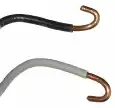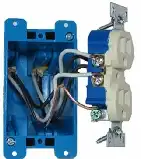
Switches | Outlets & Plugs | Ballasts | Replace Ballasts | LED Tube Lights | Troubleshooting | Basic Electricity | Misc Articles
About Privacy Policy Sitemap Copyright © 2025 Electrical101.com Terms of Use
Outlet vs Receptacle
Electrical outlet is a very common name for a receptacle. Many home improvement stores use the term “electrical outlet” when referring to a receptacle. Outlets are the points at which the electrical system is accessed (receptacle outlet or lighting outlet). A lighting outlet is an electrical box where a light fixture is mounted and gets power. A receptacle outlet is an electrical box where an outlet is mounted and gets power. On this site, the common term outlet will be used instead of receptacle. Find Outlets
When to Replace an Outlet
The most common reason outlets need to be replaced is because of physical damage. Rarely will a standard outlet fail electrically (line and neutral present at the terminals, but not at the plug). If an outlet is cracked or a plug is loose fitting, it is time for it to be replaced. When replacing an outlet, consider replacing the cover unless it looks new or cleans up nicely.
Sometimes the plastic is broken just below the ground pin opening. This usually happens when a plug is yanked out improperly from the outlet. As long as the plug fits snugly into the outlet, and there is no other damage, the outlet should not need to be replaced.
No Power at GFCI or AFCI Outlet
WARNING -
When a tester shows voltage is present on an outlet at the plug end, it is easy to tell when power is shut off at the outlet when shutting off the circuit breaker (voltage is no longer present at the plug end of the outlet). It is difficult to determine which circuit breaker supplies voltage to an outlet that has no voltage at the plug end. Unless it is known which circuit breaker supplies power to a certain outlet, all of the circuit breakers may need to be turned off before the outlet is removed.
Types of Outlet Terminals
There are three types of terminals on the back of outlets and switches.
A. Screw type terminals. The stripped wires that connect to this type are formed into a “C” shape, mounted under a terminal screw in the clockwise direction, then tightened. Sometimes the wires are wrapped completely around the terminals of the old outlet and are difficult to remove. When the wires are removed, they are cut as close as possible to the terminals. The insulation is then stripped from these wires about ¾ of an inch, formed into a “C” shape, then attached to the outlet and tightened.
B. Slide-
C. Push-
Select images below to enlarge
How to Replace an Electrical Outlet
Tools Needed to Replace an Outlet
The tools needed and the steps to take when replacing an outlet may vary if the wires are wrapped tightly around the terminals of the outlet to be replaced. The optional tools listed are for this condition.
Before Replacing an Outlet
The instructions on most electrical devices state that they should be only installed by a qualified electrician. Electrical101.com does not encourage people to do their own electrical work. The following instructions are for reference only.
Replace Outlet Instructions
A receptacle outlet tester is plugged into the outlet and the tester should show voltage is present (if there is no power at the outlet, see “no power at plug end of outlet” above). At the panel, power is shut off to the outlet and the tester lights should turn off, verifying power is off. This tester will also be used on the newly installed outlet to verify the outlet is wired properly.
- The cover is removed and the outlet is unscrewed from the electrical box. The outlet is then pulled out of the electrical box.
- The wires are removed from the outlet terminals.
- If needed, about 3/4” of insulation is stripped from the end of the wires.
- The wires are attached to the new outlet terminals. The line wire is attached to the brass colored terminal, neutral to the silver terminal, and ground to the green terminal.
- The outlet is placed back inside of the electrical box, the mounting screws are tightened, and the cover is installed.
- Using a receptacle outlet tester, the outlet is then tested for proper wiring.
Tools
- Outlet tester
- Philips screwdriver
- Slotted screwdriver
Optional Tools
- Needle nosed pliers
- Wire cutters
- Wire strippers




Wires incorrectly wrapped around terminals
Push-
Slide-
Push-
Release slot

Replace an Electrical Outlet